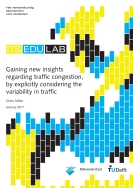In the past decades, traffic congestion on the Dutch motorway network has developed into a serious problem, causing large costs to society. In this thesis (alleviating) traffic congestion is considered from a probabilistic perspective, meaning that the variability in traffic is explicitly taken into account. Traditionally, in evaluations of the effectiveness of proposed congestion relief measures this variability is taken into account only in a limited or simplified way, or even not at all. Often simply a kind of ‘representative’ situation is calculated, possibly supplemented with some qualitative considerations or scenario-based analyses regarding the effects on the robustness of the traffic system. The main objective of this research project was to reveal what kind of new insights can be obtained if we actually do explicitly/systematically take into account the inherent variable nature of daily motorway congestion. Two different types of such additional (or revised) insights are distinguished:
- Insights into the relative importance of the various primary sources of traffic congestion.
- Insights into the effectiveness of specific traffic measures proposed to alleviate congestion.
Basically, the mechanism behind traffic congestion can be described as a process of interaction between the traffic demand and supply on the road sections of the network. Both this traffic demand and supply show a significant level of temporal variability, which makes the resulting traffic conditions variable as well. There is a large variety of sources of variability in demand and supply.
It was considered that the (potential) gain of new insights could best be shown using a model-based approach. The most obvious choice is then to use a model with a macroscopic traffic simulator as computational core. In practice and in literature, several models specifically designed for addressing the variability in traffic conditions can be found. It was concluded however that none of the considered models was completely adequate for the tasks at hand. Therefore, in this project a new model was developed. The main principle of this model is that a large number of traffic simulations are performed for varying model inputs, reflecting the variabilities in the traffic demand and supply characteristics. Subsequently, the desired performance indicators can be computed from the combined set of all simulation results.
In order to explore the (potential) new insights obtained by explicitly considering the variability, the developed model has been applied to a reasonably sized real-life motorway network. It should be noted, however, that incidents and road works were omitted from the analyses, because of the inability of the model to deal with these in a sufficiently valid way. From the results obtained with the model, it is clear that the ‘representative’ calculation does not give a good impression of the performance of the traffic system. It has been demonstrated that new insights into the relative importance of the different primary congestion sources can be obtained by ‘deactivating’ them in the model. Although the relative influences of only a limited number of such sources have been compared in this project, and only one specific test network was considered, it can be concluded that the capacity variations due to the intrinsic randomness in human driving behavior play a central role in peak period-related traffic congestion. The demand variation over the months of the year plays an important role as well, while the ambient conditions (i.e. weather and daylight/darkness), events and the intrinsic randomness in travel behavior seem to have a much smaller (or even negligible) influence. Ignoring the influences of incidents and road works, events seem to be the most important source of weekend day traffic congestion.
By considering the example of a rush-hour lane, the research has shown that new insights can be obtained into the effectiveness of specific measures that are proposed to alleviate traffic congestion. It turned out that the ‘traditional’ way of evaluating the effectiveness of a measure may actually result in a significant underestimation of the benefits of this measure.
